Snenokle means “eggs in snow” in Serbo-Croatian.
In France, where it is thought that this dessert originated, it is called Å“ufs à la neige (“eggs in snow”) or île flottante (floating islands). In Hungary, it is called Madártej (Floating islands) and the Hungarians may challenge the French regarding the origin of this creation. In Serbo-Croation it is called Snenocle and those from the former Yugoslavia won’t challenge anyone about the origin of this dessert. They don’t care who created it. They just love to make it with their hand picked farm eggs with the darkest yolks possible. Vanja’s brother, Igor (Now, don’t laugh; think about who created a stigma attached to this honorable Eastern block name, and why…), loves this delicacy, so Pava (Vanja and Igor’s mother) always has it waiting for him every time he arrives to visit her. I have been there many of these times, and was graced with a “taste” of it. But, no one else was every given any. It was his. From his mother’s hand, for him. No one else liked it as much as he, and that is how this family works: sacrificing for one another, even these little things.
After one taste, I was hooked. I wanted some! But, would never let it be known. I just asked year after year if Pava would show me how to make it. Every year, the answer was “Yes, tomorrow!” and she would make another batch the following day, but would forget to summon me. Or choose not to. I was never sure.
I don’t speak her language. She doesn’t speak mine. But, we respect one another. She is a hard working loving mother-in-law. She is four foot nothing and a force to be reckoned with. The stress of the Bosnian war has taken its toll upon her. The folded and deepened lines on her small and wizened face tell that story. She is stubborn and strong and can be incredibly annoying, but she does have the best of intentions.
This time, I arrived in Bijeljina and there was a surprise waiting for me. Pava is not short on drama. She is actually over the top in that area, but not alone in that department, in this culture. There was a big production and over-the-top presentation as she came out of the kitchen and around the corner producing: TA-DA, this dessert for me!
Igor had not joined us for the first leg of this visit, and I was basically in shock. First of all, why for me? Second of all, why all the drama? I learned later that she had been pestering Vanja about something she could do for me, and this is what he suggested, reminding her that I had wanted to learn to make this for several years. That was very kind of Vanja and a very loving gesture from my mother-in-law. It was light and lovely and wonderful. I am completely hooked. And, the second gift: I got my lesson the first day back from their 50th anniversary celebration (which I will post another time)!
Vanja was gone with his dad the next day and had left me to learn how to do this from Pava by myself. Did I say she and I speak different languages?
I have learned enough nouns and simple Serbo-Croation to manage. We had a wonderful time. Whether we really understood each other or not, we will never know, but we both thought we did! First, some eggs were from one of her sisters and others from a niece. We had just returned from their 50th anniversary celebration in Kozarci and stopped on the way out several times at several places to say good-bye to several people. (That’s what they do. Sound familiar to anyone?)
By the time we were on the road, we had eggs from many, and garden vegetables, and fruit and whatever else people could find in their house and stuff into our car as we were trying to drive away. That is part of the culture of this loving and generous people.
Today, Pava told me that she was making a huge batch. I could see that. She was using ten eggs! The litre of milk went into the pot.
This was heated to almost boiling, but not quite: scalding.
As the milk was heating, she cracked open her niece’s eggs and flapped her arms and cooed and ooed and ahhhed and chortled about how gorgeous the zumance (yolk) was… divno jaja! Divno jaja! Vidi! Vidi, Valeriski (why I get called this is beyong me)! She was saying, “Gorgeous eggs! Look, Valeriski! Look, Valeriski!” I was responding back with all of the depth of understanding I could muster: “Da! Pava! Da! Divno jaja!” Meanwhile, I was having a heart attack.
I had never seen an egg with an orange yolk. Deep yellow, yes: orange, never. Was it good? I smelled it. “Ah, Valeriski! Super!” (“Super” is a Serbo-Croation word, too.) It didn’t smell bad. I asked her in my rudimentary way, “Zasto orange?” (Why orange?) and she answered,”Jedu kukuruz.” “Ne razumem, Pava.” “Jedu kukuruz.” That is the way it is with Pava and I. I tell her I don’t understand, and she repeats it. I tell her I don’t understand and she repeats it again, either slower, or louder. I probably do the same with her. Eventually, she said, “Jedu Proja.” Then I got it. Proja is a traditional Serbian dish similar to Italian Polenta, made with cornmeal. “Ah! The chickens are fed corn!” “Da! da! da!”
Apparently, (once Vanja returned I double checked my understanding of this conversation) the villagers and farmers take great pride in the colour of their yolks and the redder, the better. This is created by feeding the hens almost completely corn.
The photo below has not been altered. The colours on my computer are very similar to how they were that day: a yellow yolk, dark yellow yolk, an orange yolk, and a very intense orange (or almost red) yolk. If I didn’t take the photo, you would have never imagined that my description was true. Or, would you? These yolks, and more, were added to the sugar, and the whites were separated from them, and set aside.
There is not doubt about it, I was enchanted by the colour of these yolks. They definitely peaked my curiosity.
In this country, one can still not find vanilla. The mega stores have cropped up the last five years, and some western ingredients are available, but few. Vanilla sugar in small packages is what is used when vanilla needs to be added. Vanilla beans are available, but not vanilla extract. Pava added two of these into the yolk and sugar mixture as this was such a big batch.
She then beat the egg whites until they were still. It didn’t take her long.
She showed me the stiff peaks.
Then she held the whites upside down over her head and looked at me and said, “Ah? Ah!” with a triumphant smile. “Bravo!” I clapped. (I can do drama, too!)
Time to poach the islands in the milk. She took spoonfuls of the whites and gently ladled each into the scalding milk until the surface was full of them. They would puff up in a minute or two, and as that happened, she would turn each one over.
You can see the concave shape they are placed in first, and as each is turned, a convex shape emerges.
Pave didn’t leave the clouds poaching as long on the second side as she had on the first and when it felt “done” she ladled it out with a slotted spoon and sat the clouds, or islands, aside.
And so it went until this bowl was empty (below) and the tray (above) was full.
The are looking very good!
The yolks and sugar had only been partially beaten at the onset. Now she added a little flour to thicken it, and beat it until very thick and brilliant yellow. This mixture was tempered into the milk mixture that had originally poached the eggs.
It was cooked until it thickened and was velvety and smooth and lush. The clouds have been divided into two bowls.
Pava pours the yolk, milk and sugar mixture (Crème Anglaise) onto and between the islands.
Absolutely gorgeous.
I was impressed by the ease with which Pava did this.
And now, they must sit until room temperature, and then go into the fridge.
I believe she made these five times while I was there. Between this, and her ajvar, I was in heaven. They will never look this gorgeous here unless I use food colouring, or unless someone knows a farmer who has eggs with red yolks.
Many hot nights in the Bosnian summer, this delicate labour of love was a welcome bowl of chilled light summer comfort. Lucky, lucky me. And, no one else would eat it. Not even Igor. He had his, and I had mine. I guess I am definitely part of the family, now!
Floating Islands Recipe (serves 8)
(Pava says: use 4 eggs in 1/2 litre of milk for 2 people, and adjust other measurements, accordingly)
Ingredients:
- 1 litre whole milk
- 10 eggs
- 1 heaping tablespoon of sugar per egg yolk
- 5 heaping tablespoons of sugar (to add to the 10 whites)
- 2 vanilla sugar (seeds from 2 vanilla pods)
- 2 tablespoons of flour (to add to the yolks with sugar)
Instructions:
- Separate eggs
- Place the whites in one big bowl (you will need to beat these into stiff peaks in this bowl)
- Place the yolks in a medium or large bowl (you will need to beat the sugar and yolks in this bowl)
- Add the 10 heaping tablespoons of sugar to the yolks
- Add the 5 heaping tablespoons of sugar to the whites
- Put the litre of milk in a big pot on the stove with the vanilla seeds and pods; scald the milk, and set aside for 10 minutes infuse
- Strain the milk (Pava didn’t do this, but she didn’t use vanilla pods); and reheat to scalding, but do not boil
- As the milk is heating, beat the whites until stiff
- Using a large spoon (tablespoon from place setting), scoop “clouds” of white into the hot milk to poach; adding more until the surface area is full
- Turn these after a couple of minutes in the same order they went into the pot in; poach for another minute ]
- Using a slotted spoon, scoop our the poached clouds of egg white and place on a plate; continue until all whites are done
- Beat the sugar and the yolks together until frothy and thick
- Add the flour to this mixture, and combine
- Add some of the warm milk to this mixture, and beat it in to temper the mixture
- Slowly add the tempered yolk mixture to the the warm milk, stirring rapidly to incorporate it
- Keep the heat at a medium, and stir constantly until the mixture covers the back of a wooden spoon (thickens nicely)
- Place the clouds into one or two large serving bowls, or several small ones
- Pour the yolk mixture over the clouds accordingly (into small or large dishes)
- When the portions are room temperature, chill until serving time
These can be enjoyed at room temperature or cold.
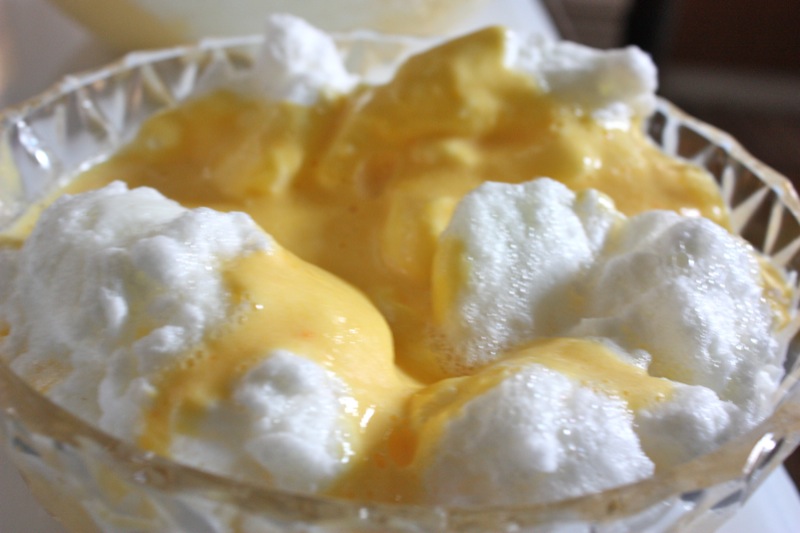
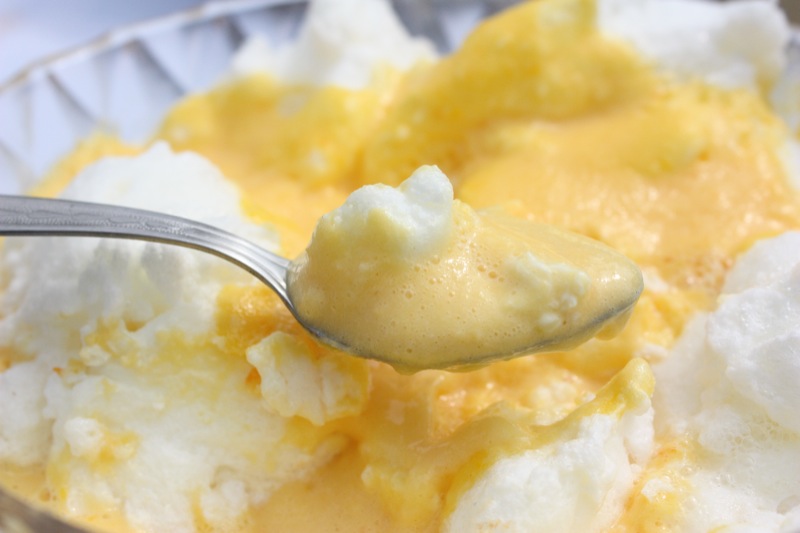

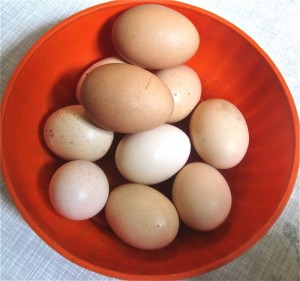
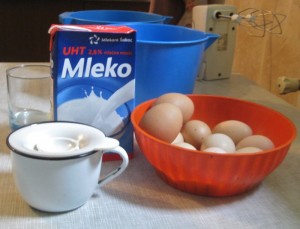
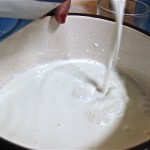
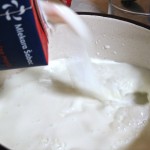
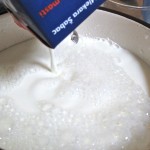
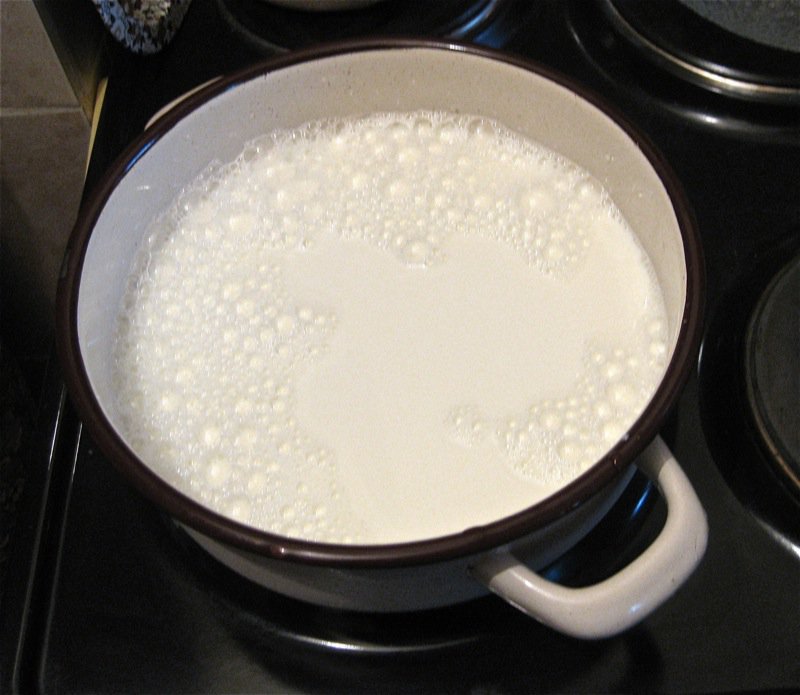
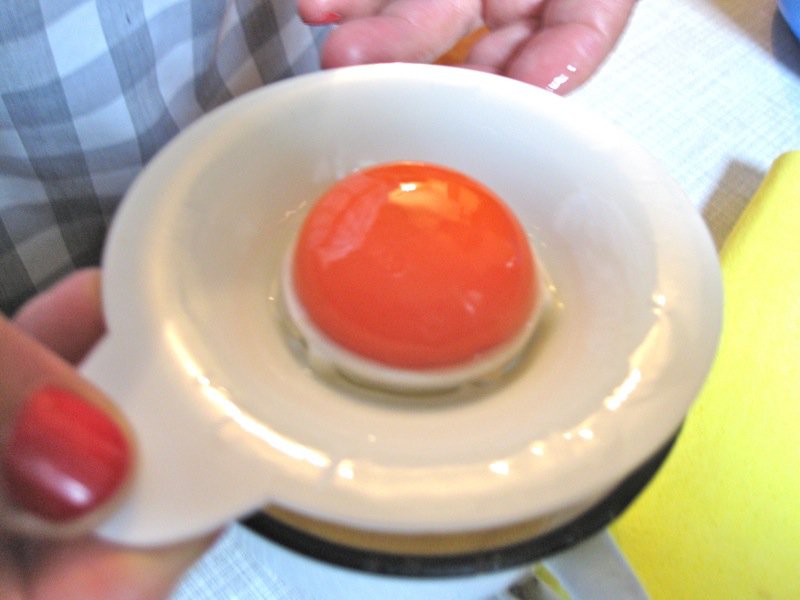
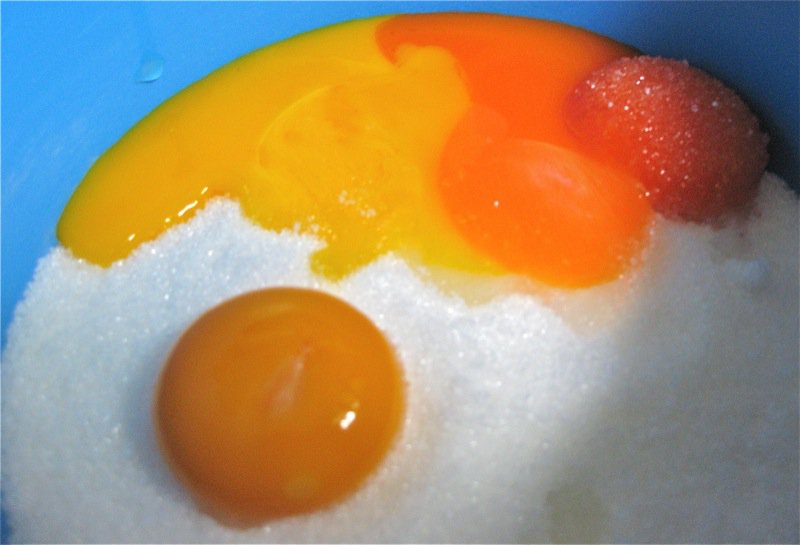

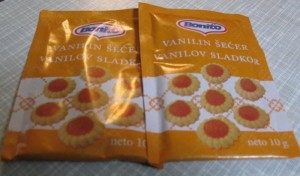
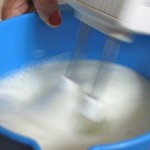
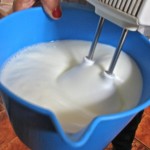
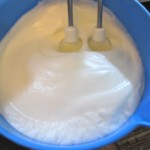
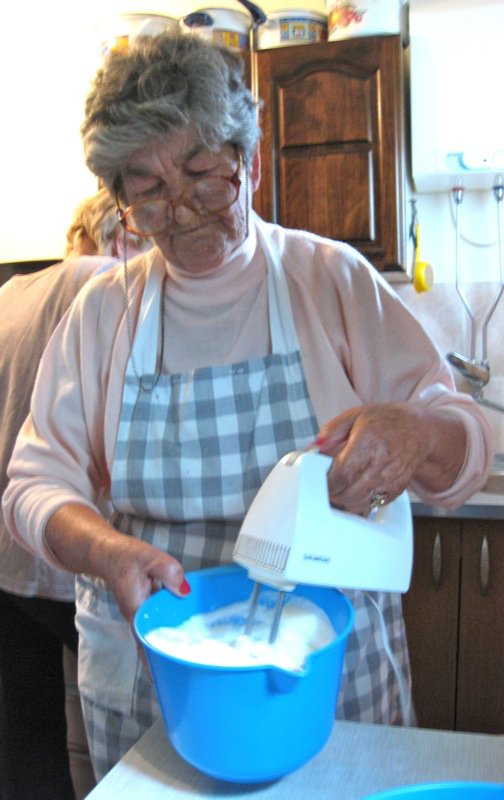
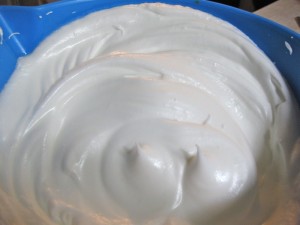
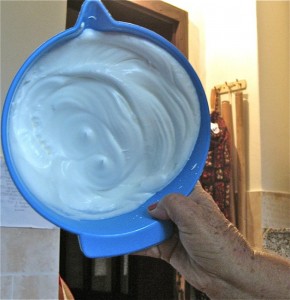
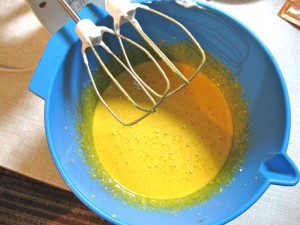
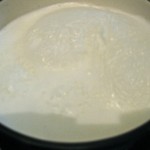
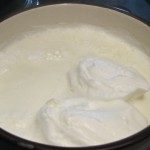
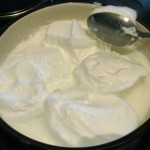
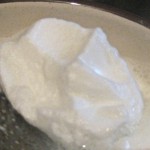
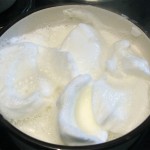
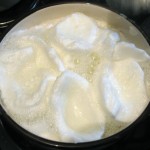
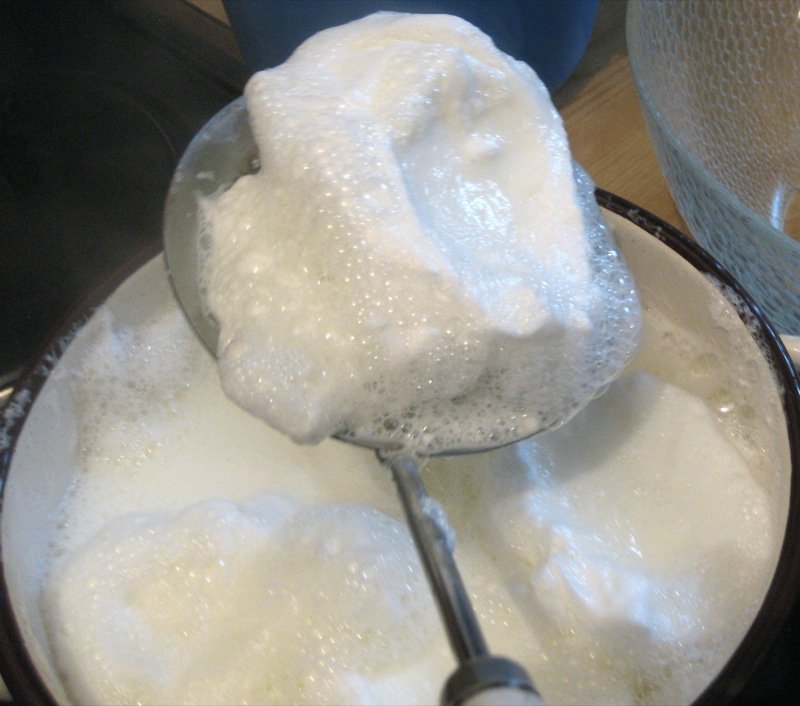

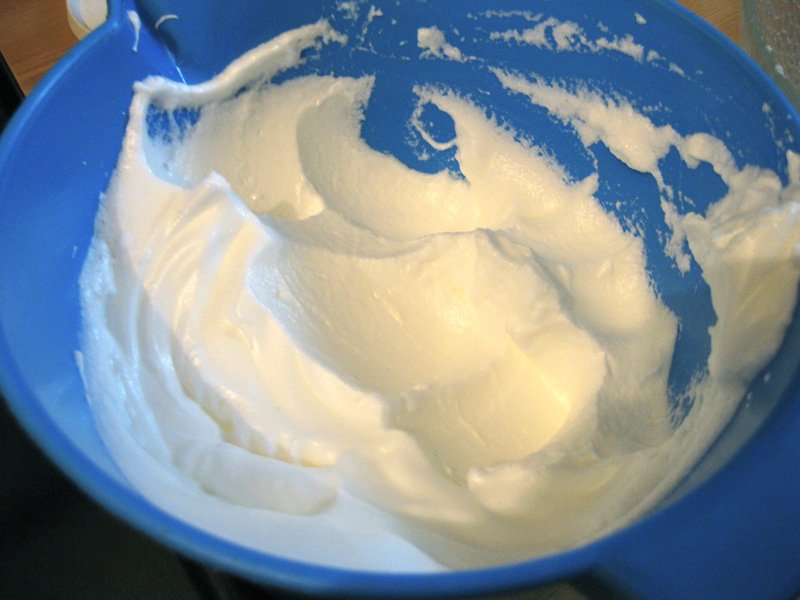
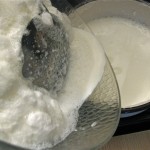
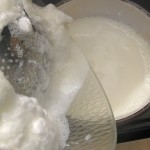
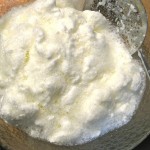
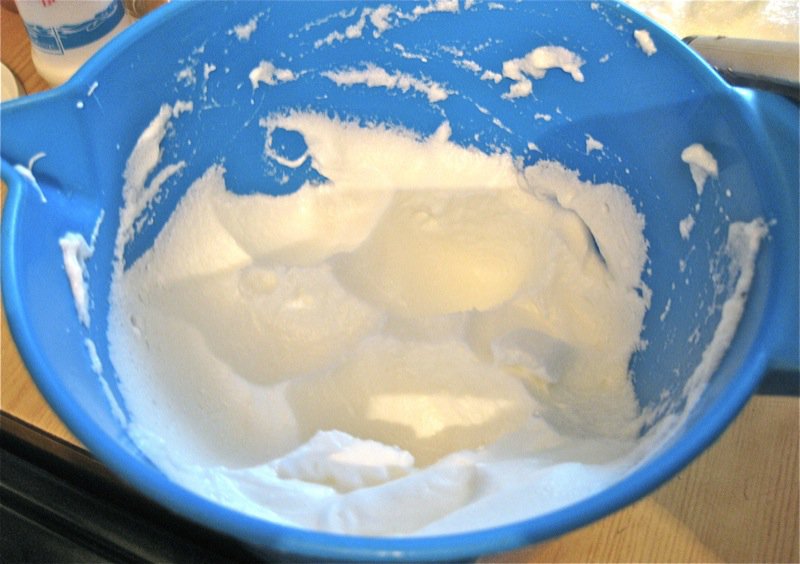
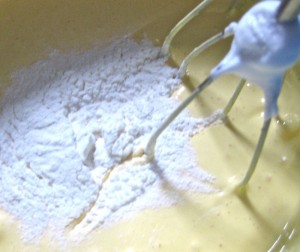
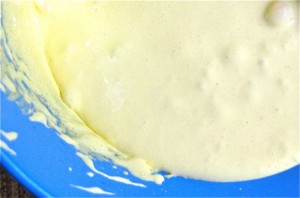
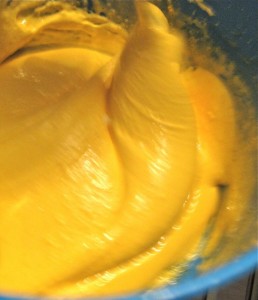
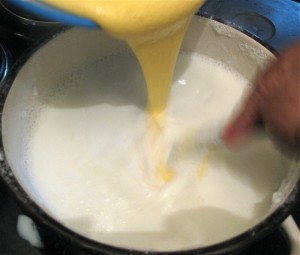
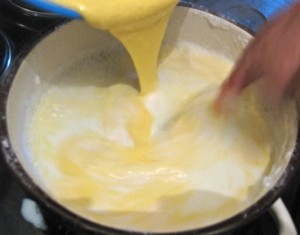
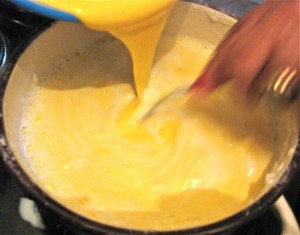
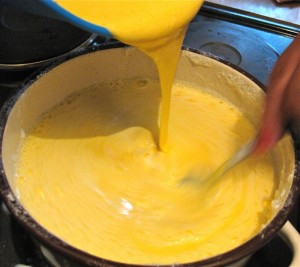
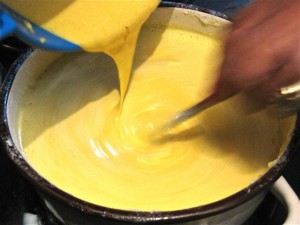
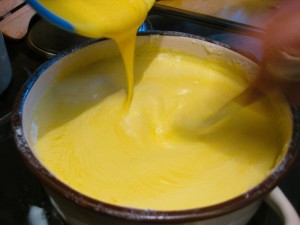
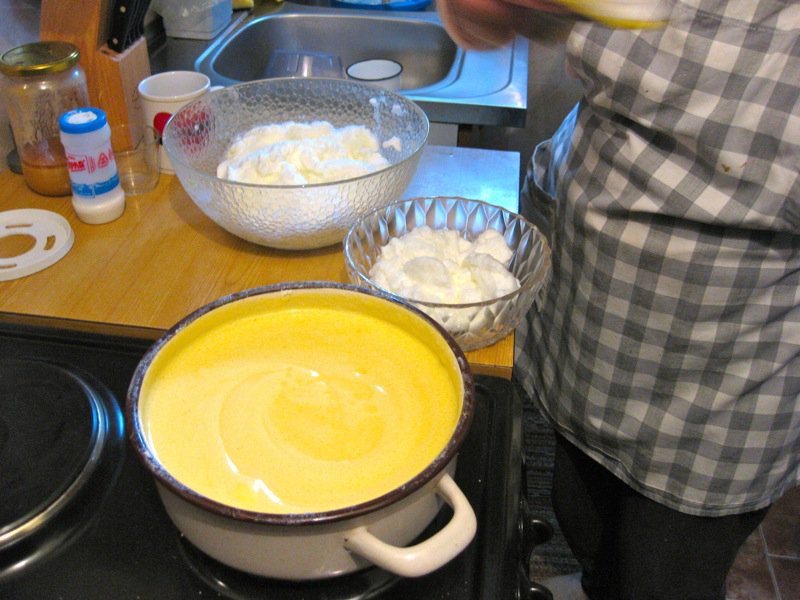
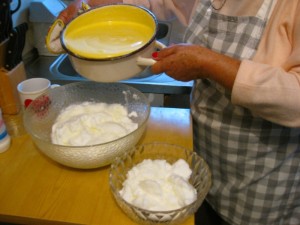
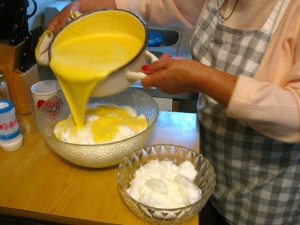
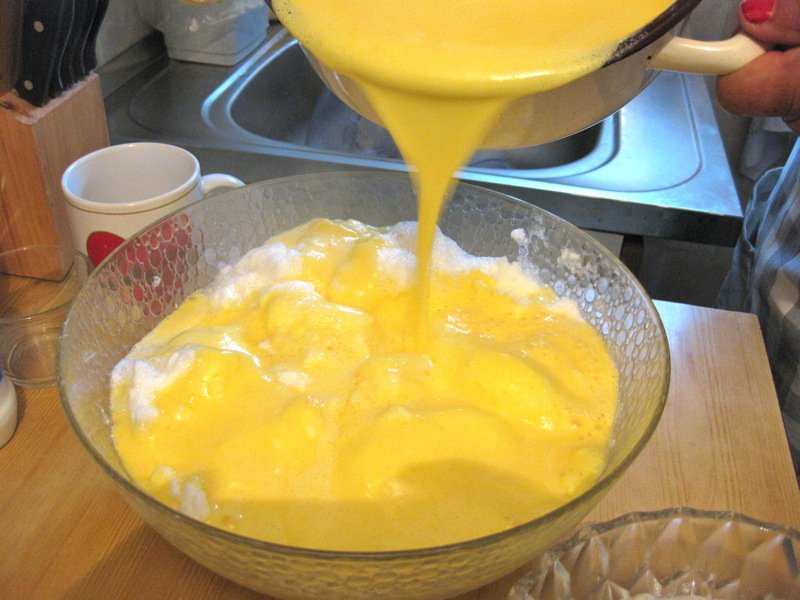
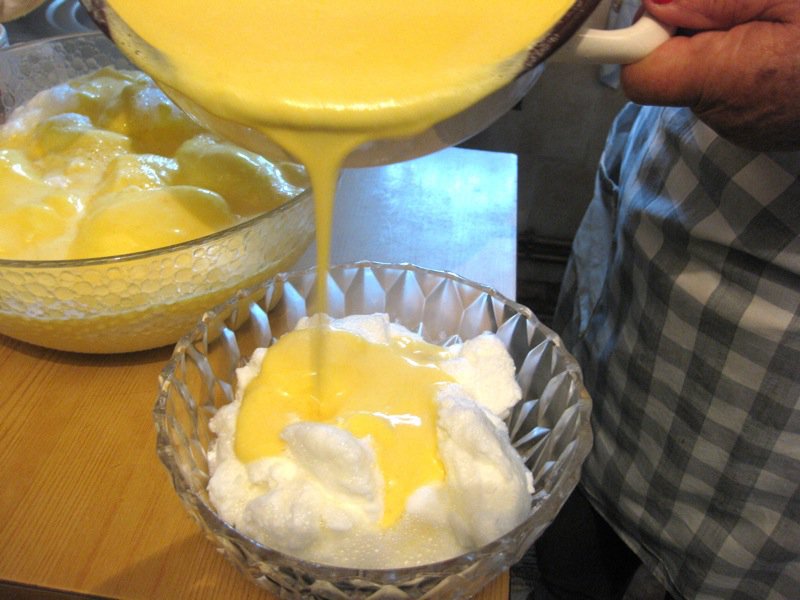
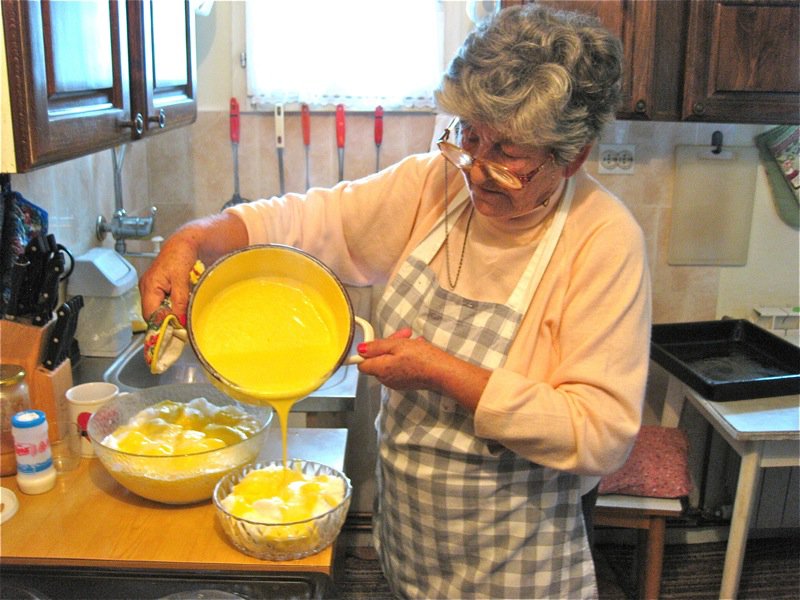
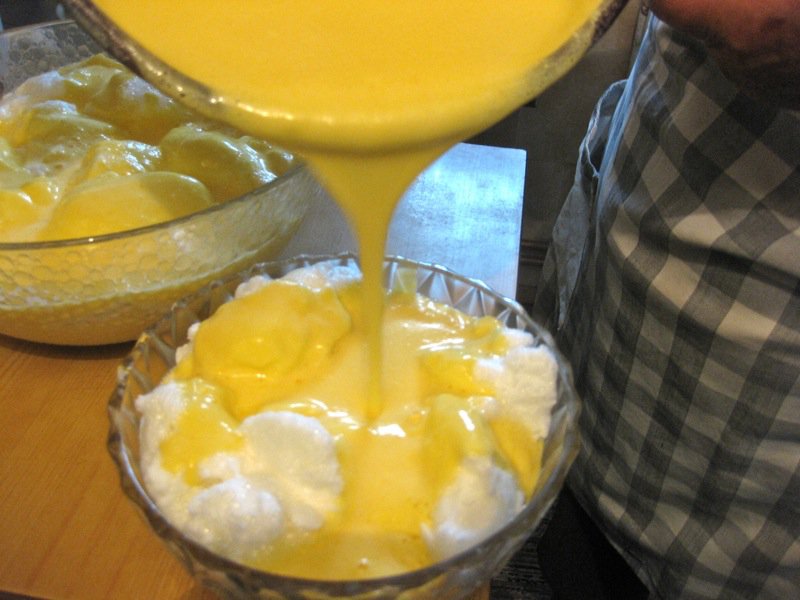
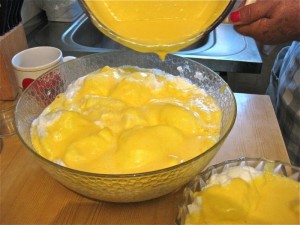
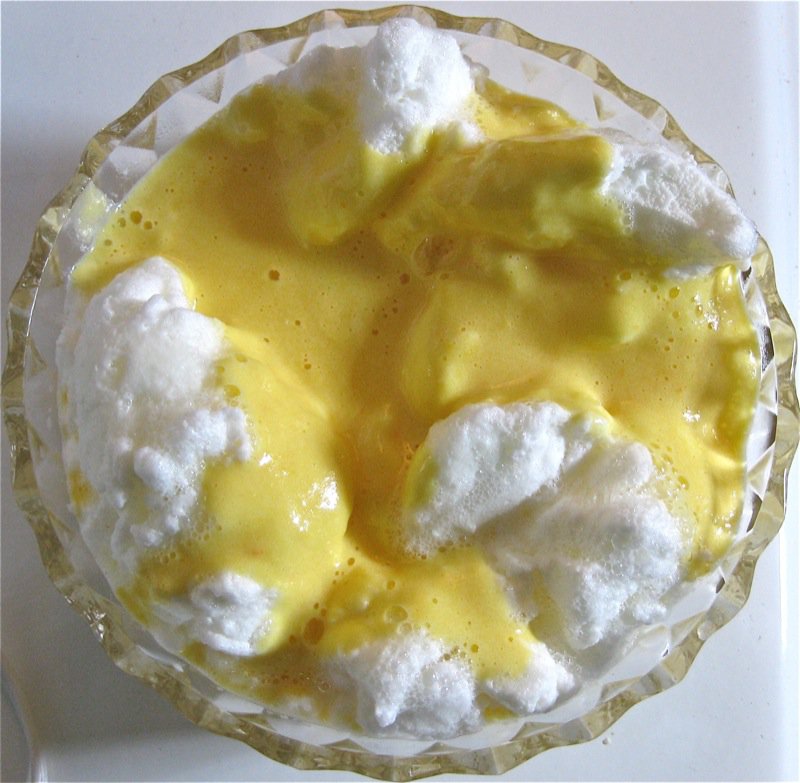
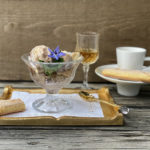
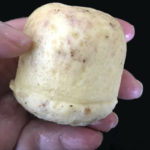
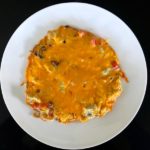
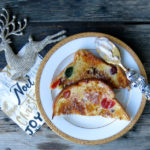
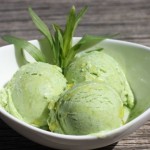
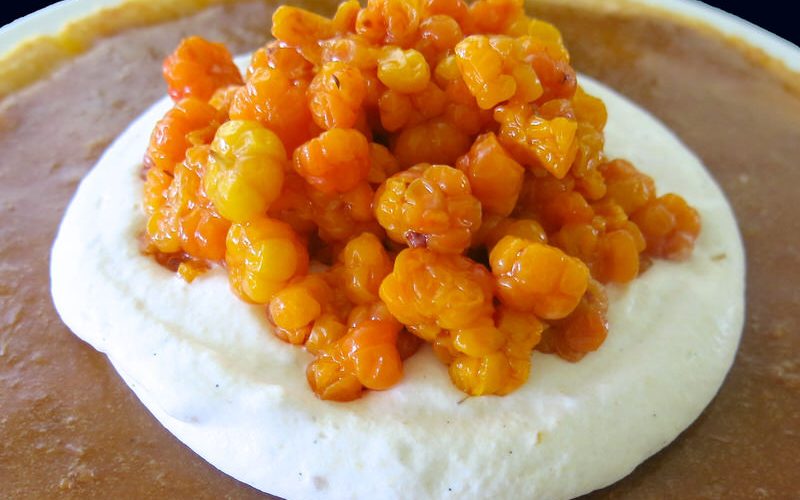



Valeriski 😀 you had me laughing out loud so many times while reading this that K turned to me and asked, “what Mommy? What? Why is the phone so funny? Can I see?” Oh my, your mother in-law sounds like such a sweet woman! I adore the relationship you guys have. I can totally understand how hard it is to communicate with your mother in-law when you both speak different languages. When Gary and I first got married, my Chinese really sucked. So everytime I tried to speak Chinese to my in-laws, they would turn to Gary if they didn’t understand me. But luckily they spoke English too. Through the years my Chinese has improved (at least I hope it did).
Those eggs have such amazingly different colours, and beautiful too, might I add. Those are the most delicious eggs in snow and floating islands I’ve seen :-D. Cooking with your mother in-law is such great bonding time. What a very sweet gesture on Pava’s part! I loved reading this Valerie! Thank you for sharing this wonderful recipe.
Valerie, what a lovely, light and fluffy recipe. I’ve never had anything Croatian and this would be a great start.
Btw, you can now subscirbe on my blog and get e-mail updates 🙂
Nisrine
Valeriski, that is too funny:D This is a very informative post. Off subject..I also wanted to let you know that at the Food and Wine Workshop I learned a little about sous vide and also tasted lamb at one of the restauranst we attended that was cooked by that method. ….simply tender is not the way to describe it!!!
Floating islands, à la neige, île flottante, Madártej…I have learned something new today…I wouldn’t care who created it either…it’s created and it’s delish. That’s far more important. I would love to taste the egg yolk…looks so fresh and different from the Bio-eggs I got from here…so much richer. Poaching cloud…wow, that takes patience and skill..Your mother-in-law is sweet.
Oeufs à la neige! The name brings you visions of smooth creamy cloud on your taste buds. What a lovely demonstration; I just love Pava’s picture; you are a lucky girl to live this experience. Great post as always.
Rita
I remember seeing the Barefoot Contessa making this on her TV show. Great step by step pictures!
*kisses* HH
p.s. i can do drama too 😉
HH:
You MAY do drama, but no one can do it like my dearest Pava!
XOXOX
Wow, these look so light, fluffy, and so tempting! I would be totally addicted to these yummy treats!
I have to tell you that I came over from David Lebovitz’s site because you mentioned Yugoslavia. My grandmother was from there and came to the States in the late ’40s. As I was reading this post I got to the picture of Pava and instantly longed for my grandmother again as their faces are quite similar. It’s a worn and weathered look she wore well, as does Pava. Thank you for the post and the delightful memories it brought back.
I am going to call you Valeriski from now on! lol!
Now this was a lovely story and I think too that this episode sealed your acceptance into this family.
I have seen eggs like this in Iraq, about 35 years ago: they were the best eggs I had ever tasted too, and huge, bright orange yolks that we ate for breakfast with arabic bread and clotted cream.
This homestyle floating islands reminds me of a little old lady in Aix-en-Provence who used to make me some, she was so sweet, I will never forget her or her île flottante.
I’ve missed you too!
I love that floating island is a dessert of many countries. I remember it originated as a nursery dessert in France (just about the only country where you can still order it in restaurant) and my mother made it for us all the time. As I did when my kids were little. I still love it; it’s true comfort food.
I posted mom’s recipe a while back and changed the way she did the “isles”. Mother used to poach them as Pava does, but I learned to bake them from someone online and I now prefer this way as they are a tad firmer and we love the peaks and valleys of doing them that way rather than the slightly rounded way poaching results in. The creme anglaise is the same, pretty much.
What a gorgeous color those yolks were!
Thank you, Barbara! I will look at your baked recipe the next time I go to make them. What a great idea. I know that Pava’s way is the rustic country way, and that is what I love about learning from her… and what I love about blogging is learning how to do it better!
XO
Valerie
This was a most awesome post. I loved it! You know when Pava taught you how to make eggs in snow, she really meant that you were part of the family. I know that you wrote this, but, that is one of the first thoughts that came to my mind.
Holy cow! The red egg yolk. That was amazing. I enjoy farm fresh eggs every week. The yolk is a deep orange but almost red? Not close. How cool!
It’s so sweet how your Pava realized that you appreciated wanting to learn something so special. That generation is quick and not much on show and tell.
When I was visiting in the stunning coastal areas of the former Yugoslavia…Hubby and I had the opportunity of having this prepared in small bed and breakfasts throughout the area. Many ‘Pava’ type women were greatly appreciated ;o)
Have a great weekend Valerie and flavourful wishes,
Claudia
This is one bloody awesome post, Val….look what you’d done to me – I have been rediced to cussing – yah! this post is thaaattt good 🙂
I can’t believe how easy Pava makes this look and how stiff those peaks are and what a concept! Just WOW all the way through 🙂
Ciao, Devaki @ weavethousandflavors
What a delicious recipe Valerie! I have had ile flotantes before and totally loved it, but I have never attempted to make them myself. And you’re right; the color of those egg yolks is just amazing!
Lovely clicks and beautiful presentation!
Another wonderful journey. What a precious gift you give to me Val! I love Valeriski! It’s her pet name for you no doubt and I find it endearing. They say that music is the international language but I’m seeing that for you it’s cooking. 🙂 Thankyou for sharing all of your wonderful experiences!! These pictures are amazing. yum!
OXOX
Oh my! What a great story about a wonderful traditional recipe. Thank you so much for sharing! ~Alison
A very similar dessert is served in Portugal, called Farofias (a mouthful even when you speak the language!!). The custard part is usually lemon-flavoured (by adding lemon peel to the milk) & it is often topped with a sprinkle of cinnamon. Delicious! Love seeing how a recipe evolves/changes depending on where you are. Terrific blog.
Valarie, thanks for the recipe. I grew up with snenokle in ex-Yu and wanted to make it for my kids. BTW, snenokle does not mean “eggs in snow” – it actually doesn’t mean anything in serbo-croatian.
Actually, it means “Snow Noodles” but in German. The original name is “Schneenockerln” and basically, it is an Austrian dessert. It is pretty common in those parts of former Yugoslavia which belonged to Austro-Hungarian Empire before World War I. http://daily-helper.com/en/165788
Dada
Interesting, isn’t it, how translation varies from place to place? Always love learning the history of food.
🙂
Valerie
Hi Valerie
I came across this post looking for original recipe (in serbo-croatian) to give my daughters to make for Christmas. I used to make it quite often as teenager and very occasionally now. They read this post (English is easier for them) and I will have big bowl (or few) of it this Christmas. Pictures are great. Look so yummy. I see you tried ajvar (another of my favorites). Did you by any chance try “sarma” (sour cabbage meat and rice rolls, I am making vegetarian version for my daughter as well)?
Great post!
Mirjana
You bet! Search for Sarma! Christmas would not be the same without it!
Thank you so much – check out my Burek, too!:)
V
I have enjoyed reading your blog – I actually just wanted a little reminder how to make those sne-nokle, we called them in my family madar-tey, and translation was according to my Mom “meringue-noodles”, or Hungarian/Magyar “birds’milk” – according to my Dad! And I do add little lemon zest to milk, instead of flour I use corn-starch! But those are the same tasty clouds, islands or whatever you called them…
Zuzana
Wonderful to hear such a lovely sharing about this recipe! Love those family tidbits! Thanks so much for chiming in!!
🙂
Valerie
Hi, lovely report..however, snenokle doesn’t mean eggs in snow in Serbo-Croatian as in direct translation. It’s an Austrian-German word. Also Igor is not an “Eastern Block name”. 🙂 (Yugoslavia was never in the Eastern block and Igor as a name exists far longer than SSSR..think of Igor Stravinsky for example).
Dear Inka,
I have been to the former Yugoslavia about 10 times and am married to a man from there. As anywhere and everywhere, there are different opinions and perceptions of everything. Thank you for chiming in! That is why I do what I do. These are our opinions and our experiences. I so very much appreciate your input!
Happy Holidays!
Valerie
Hi Valerie,
I often make snenokle, but haven’t done so lately, so I wasn’t sure any more about the quantity of flour to add,. My first reflex was to call my mom, but it was already 1 AM in Serbia and since the internet is faster than trying to find my mom’s recipe among tons of others, I found your post:)
Thank you, your story made me smile and miss my mom so much. I am Serbian, so I only get to see her once a year when I go back for a visit. And yes, she loves those dark yolks as well and since we have always lived in the city, she finds ways to get some from friends in the country.
The name sne nokle does originally come from the german schnee (snow) and nocklern (something roundish like dumplings). But in Serbia, it’s been used for such a long time that I consider it a serbian word for such a great dessert (I agree that it doesn’t matter whose invention it was originally:).
Cao (another serbian word, right:),
Sabrina
Lovely to hear from you, Sabrina!
Hugs,
Valerie
What a lovely, sweet story, and of course your photo essay is always delightful.
I’ve had some intensely coloured yolks with my hens, but never anything like that red one! Feeding them tatsoi, which they love will give me very dark yolks that are also weirdly thick, almost waxy; delicious, but their thickness makes it hard to beat them into anything.
I haven’t made this dish in years, but you have jogged me. Cooking for only two, this should be even easier using the Thermomix.
I cannot wait to try the guided recipe for this in the TM5, Peggy. I was delighted to see it there. Is it also in your cookbook? I know our recipes vary a bit. I cannot wait to hear how it turns out. I am currently back in Belgrade and was actually wanting to make this very recipe for Igor – though he is gone… thinking of Pava and how she would want her eldest son to be comforted and welcomed by this velvety eggy cream just once again while visiting here.
XOOX
Valerie
I love Shnenokle, my mum used to male tjis dessert a lot while we were growing up. We made it together couple of days ago, and she was just as secretive as your mother-in-maw about teaching me how to make it 😀
Your story touched me. Food truly is what bind us all.
Thank you so much for chiming in, Viktoria
You are so right!
I am craving some – and time that I will never have again, with the lovely Pava.
OX